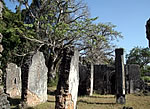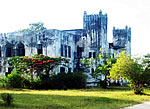Introduction: TANGA

History: TANGA

Tourist Sites: TANGA

Hotels in Tanga

History: BAGAMOYO

Hotels in Bagamoyo
 |
Tanga & Bgamoyo
Tanga is both the name of the most northerly seaport city of Tanzania, and the surrounding Tanga Region. It is the Regional Headquarters of the region.With a population of 243,580 in 2002, Tanga is one of the largest cities in the country. It is a quiet city compared to, for example, Arusha or Moshi with a comparable number of inhabitants.The city of Tanga sits on the Indian Ocean, near the border with Kenya. Major exports from the port of Tanga include sisal, coffee, tea, and cotton. Tanga is also an important railroad terminus, connecting much of the northern Tanzanian interior with the sea. Via the Tanzania Railways Corporation's Link Line and Central Line, Tanga is linked to the African Great Lakes region and the Tanzanian economic capital of Dar es Salaam.
The harbour and surrounding is the centre of life in Tanga. It is stretched out several sqkm into the country. It has several markets in several neighbourhoods.Tanga Region has seven districts: Tanga, Muheza, Korogwe, Lushoto, Pangani, Handeni and Kilindi.
[TOP]
History
Tanga was chosen in 1889 as a military post of German East Africa, and became a district office in 1891. The local economy was based on sisal, which had been brought to the colony several years earlier, and population in the area grew rapidly. The town was also established as the terminus of the Usambara railway line, which runs inland to Moshi at the foot of Kilimanjaro. The name Tanga comes from the word for farm or cultivated land in several of the local languages (including Sambaa, Bondei, and Zigua.
As the coastal town closest to Kenya, Tanga was on the front line at the outset of World War I. A British landing was thrown back on 4 November 1914 in the Battle of Tanga, and the town was not taken until 7 July 1916.
[TOP]
Tourist Sites
Nearby tourist attractions include Amboni Caves, Toten Island, Tanga War Graves and Memorials, Tongoni Ruins, Ndumi Village defence works, Mwarongo sand beaches and protected coastal mangroves. Moa Village and other small village around also Pangani District might be a leisure and Beach relaxing place for its white sandy beach.
Lushoto is very notably visiting area because of its cool weather condition that Europe countries experience.
The town has been moderated by Germans and they love this town as historical some of the names of streets in Germany are the same as those in Lushoto and Tanga.
[TOP]
Hotels in Tanga
The hotels can be booked for accommodation but to be honest the Tourist services in Tanga still very limited ,clients should not expect 5star services.
[TOP]
Bagamoyo
Until the 18th century: A minor center of commerce
Until the middle of the 18th century, Bagamoyo was a small, rather insignificant trading center. Trade items were fish, salt and gum among other things. Most of the population consisted of fishermen and farmers.
19th century: The arrival of the Arabs. Bagamoyo became a central point for the East African slave trade
The importance of the place changed drastically from the moment Arab slave traders decided to use Bagamoyo as the final destination for their slave caravans from the center of the country. Towards the end of the 18th century about 12 Muslim families settled in Bagamoyo, all of them relatives of Shamvi la Magimba from Oman. These families made their living not only by enforcing taxes (taxes were placed even on things like slaughtering goats or catching fish), but also by trading in salt, which was gathered from the Nunge, 3 km north of Bagamoyo. Slaves were kept imprisoned in Bagamoyo. At night they were transported by ship to the slave-markets in Zanzibar. This explains the meaning of the word Bagamoyo ("Bwaga-Moyo") "Lay down your Heart". Those who had been deported from Bagamoyo never got another chance to see their home country again.
For further information on this, we recommend the very impressive story "Tears of Fear, Tears of Joy - the story of the slave girl Siwema", published by the catholic mission of Bagamoyo.
1868: The founding of the catholic mission
In 1868 Muslims presented the "Fathers of the Holy Ghost" with land to build a mission north of Bagamoyo - the first mission in East Africa. After the intervention of the French consul in Zanzibar, the resistance of the native Zaramo people against this "present" was put down by Sultan Majid and later, after 1870, by Sultan Barghash.
In 1892, the grounds of the mission were enlarged by a gift of land from the Muslim and philanthrope Sewa Haji, who originally came from what today is Pakistan. He was an incredibly rich man who owned several shops in Bagamoyo, supplied caravans and traded with cloth, copper, gunpowder, ivory and rhino horn. He gave the mission 20,000 ha of grounds and a three-storey school for multi-racial education (Africans and Asians) in the middle of the town of Bagamoyo. In addition, Sewa Haji also founded the hospital of Bagamoyo, which later was taken over by the Germans.
19th century: A starting point for the expeditions of Livingstone and others
[TOP]
Stanley started in Bagamoyo to meet Livingstone at Lake Tanganyika.
But Bagamoyo wasn't just a trade center for slaves and trade goods (ivory or copra, which was won from coconuts and was used for the production of soap) or a center for boat building, but also the starting point for the first European "discoverers". They moved out from Bagamoyo to find the source of the River Nile or to explore the inner lakes, which were still shrouded in mystery in those times. Among those who started their journeys from Bagamoyo were: Livingstone, Burton, Speke (who went together with Grant to solve the mystery of the Nile springs), Grant and Stanley (who broke up in 1871 with a crew of 192 and 6 tons of equipment to find the missing Livingston; and later again in 1889 when he retuned from a 3-year expedition with a crew that had been reduced from 708 to 196).
[TOP]
1874: The body of Livingstone is laid-in-state in Bagamoyo
Bagamoyo also became famous through the return of Livingstone: After a march of 9 months from Zambia, Livingston's Zanzibar helpers Abdullah Susi and James Chuma brought his dead body, dried out from the sun (and missing the heart that had already been buried in Zambia) to Bagamoyo on February 15th, 1874 ("Mwili wa Daudi" - "the Body of David"). 700 slaves took their leave of him before he was taken to England where he was buried in Westminster Abbey.
[TOP]
1880: Bagamoyo is a multi-cultural town with about 1,000 inhabitants
In 1880 Bagamoyo probably had a permanent population of 1,000. But by the year of 1889, when the slave trade was already heavily disputed, more than 1,305 caravans with 41,144 people still passed through Bagamoyo on their way into the center of the country. At that time, the population of the town consisted mainly of members of the native people of Zaramo and Doe, Shomvi Muslims from Oman, Hindus from India (who worked in administration, or on the coconut plantations and in the boat yards), as well as other Muslims, among them the Ismailites who had settled there in 1840 and whose numbers had grown to 137 by 1870, Sunnites from Zanzibar (shop-owners mostly) and Persian traders. A small group of Catholics mainly worked as tailors.
[TOP]
1888: Bagamoyo becomes the capital of German-East Africa
The Boma - former colonial German Headquarter
In 1888 the German East Africa Company signed a treaty with the Sultan of Zanzibar, Seyyid Khalifa, which allowed the company access to the coastal regions. Directly after the treaty was signed, the flagpole of the Sultan in Bagamoyo was cut down - against the heavy resistance of his local representative, who had refused to bring down the Sultan's flag. When in the course of a conflict between the German Company and inhabitants of the town the Usagara warehouse, built at the beach of Bagamoyo, was occupied, the SS Möwe put about 200 Marines on shore to deal with the revolt. More than 100 inhabitants (about 10% of the total population) died.
In the late 19th century Bagamoyo was the most important place on the coast. In 1888 the German colonial forces declared Bagamoyo the capital of the new colony and built the Boma, the German colonial headquarters. But the shallow waters in front of Bagamoyo were the reason that a few years later Dar es Salaam, with its deep-water harbour, became the new German capital city.
[TOP]
1889: Bagamoyo burns in the Bushiri-Rebellion
The historic German Customs House
The conflict between the town's people and the German colonial lords escalated when the Germans introduced registration of land and property. Never before had such a registration been demanded from the natives and they feared the Germans wanted to take away land from the native population.
That was why the Arab Bomboma organised a rebellion in Bagamoyo with the help of the legendary Bushiri bin Salim al-Harthi, who had once lead Arab troops against the Germans in Tabora. Initially, Bushiri was very successful. Large parts of Bagamoyo were burned down, and Bushiri gathered his troops in front of the city for a general attack.
The German government felt forced to support the German East Africa Company and ordered Hermann von Wissmann to put down Bushiri with his infantry which had been supplemented by Sudanese and Zulus from South Africa. To win time until the arrival of the German troops, the German Admiral Denhardt started negotiations with Bushiri, who demanded the post of governor of the coastal region, monthly payments and the right of to keep his own army.
In May 1889 Wissmann had gathered his troops and had built several fortifications. After several battles the rebellion was put down, in July 1889 the city of Pangani (north of Bagamoyo) was conquered and Bushiri was executed. The leader Bomboma and others met the same fate.
In October 1890 the Germans were granted official land rights for 4 million Mark from the Sultan of Zanzibar, and in the spring of 1891 German East Africa formally became a colony.
[TOP]
1891: Bagamoyo loses its status as capital city
Yet, because of the shallow waters in front of Bagamoyo, Dar es Salaam with its deep-water harbour became the new capital city of German East Africa already in April 1891.
From now on the Boma of Bagamoyo served as an administrative center. Many new stone houses were built, as well as a new guard house. Caravan trade stagnated, instead the influence of Indian traders grew. The first Greeks arrived and founded a European hotel in Bagamoyo. The trade company Oswald from Hamburg settled in Bagamoyo, also the company Hansing with their vanilla plantations in Kitomeni and Hurgira. A large Koran school was opened.
[TOP]
1914: Again a town of fishermen and farmers
With the departure of the Germans from East Africa the role of Bagamoyo as a trade center ended, and for almost 100 years Bagamoyo again became a sleepy town of fishermen and farmers, with slowly rotting colonial buildings, whose (lived-in) ruins remind of the glamorous times of Bagamoyo as the most important coastal town of the region.
1961: After independence Bagamoyo becomes district capital
Today Bagamoyo has about 35,000 inhabitants and is the capital of the very large District of Bagamoyo.
2005: Bagamoyo to become UNESCO World Heritage
[TOP]
Hotels in Bagamoyo
|
|
TANGA |
|
TANGA |
|
BAGAMOYO |
|
BAGAMOYO |
|
 |





